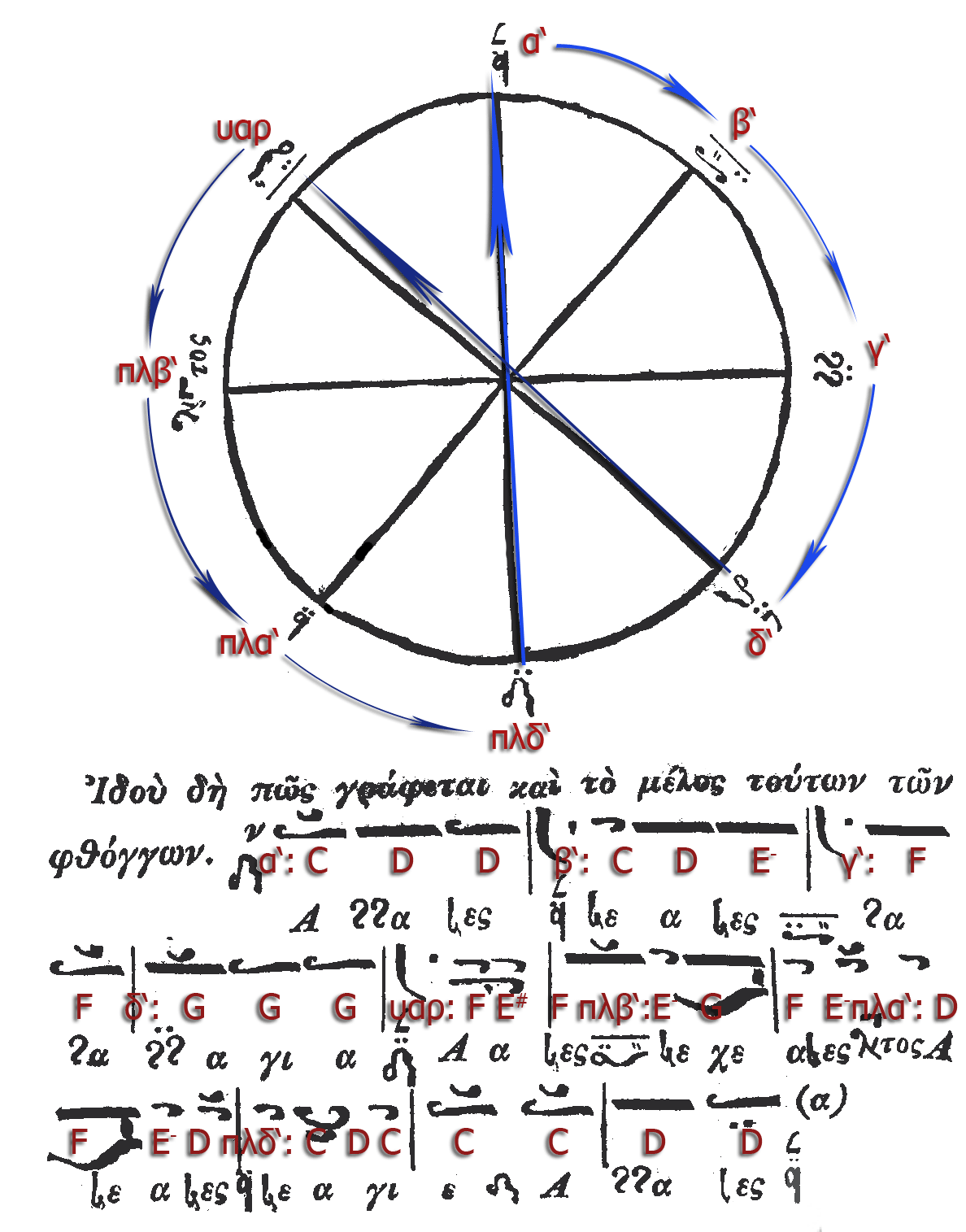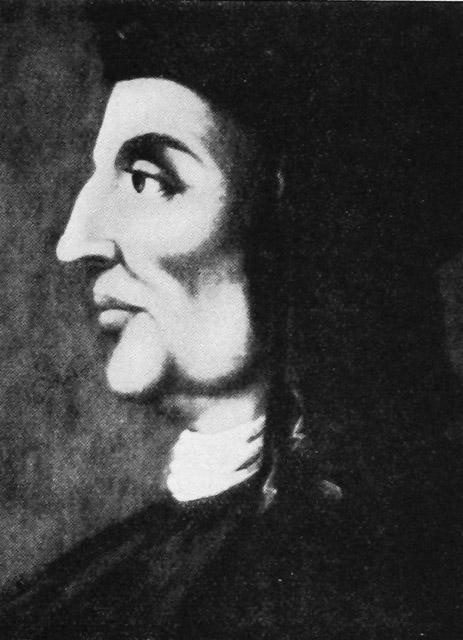|
Neobyzantine Octoechos
OktŇćńďchos (here transcribed "Octoechos"; Greek: ; from ŠĹÄőļŌĄŌé "eight" and Šľ¶ŌáőŅŌā "sound, mode" called echos; Slavonic: –ě—Ā–ľ–ĺ–≥–Ľ–į—Ā–ł–Ķ, ''Osmoglasie'' from –ĺŐĀ—Ā–ľ—Ć "eight" and –≥–Ľ–į—Ā—ä "voice, sound") is the name of the eight mode system used for the composition of religious chant in Byzantine, Syriac, Armenian, Georgian, Latin and Slavic churches since the Middle Ages. In a modified form the octoechos is still regarded as the foundation of the tradition of monodic Orthodox chant today. From a Phanariot point of view, the re-formulation of the Octoechos and its melodic models according to the New Method was neither a simplification of the Byzantine tradition nor an adaption to Western tonality and its method of an heptaphonic solfeggio, just based on one tone system (ŌÉŌćŌÉŌĄő∑őľőĪ őļőĪŌĄŠĹį ŠľĎŌÄŌĄőĪŌÜŌČőĹőĮőĪőĹ). Quite the opposite, as a universal approach to music traditions of the Mediterranean it was rather based on the integrative power of the psalti ... [...More Info...] [...Related Items...] OR: [Wikipedia] [Google] [Baidu] |
Greek Language
Greek ( el, label=Modern Greek, őēőĽőĽő∑őĹőĻőļő¨, Ellinik√°, ; grc, ŠľôőĽőĽő∑őĹőĻőļőģ, HellńďnikŠłó) is an independent branch of the Indo-European family of languages, native to Greece, Cyprus, southern Italy (Calabria and Salento), southern Albania, and other regions of the Balkans, the Black Sea coast, Asia Minor, and the Eastern Mediterranean. It has the longest documented history of any Indo-European language, spanning at least 3,400 years of written records. Its writing system is the Greek alphabet, which has been used for approximately 2,800 years; previously, Greek was recorded in writing systems such as Linear B and the Cypriot syllabary. The alphabet arose from the Phoenician script and was in turn the basis of the Latin, Cyrillic, Armenian, Coptic, Gothic, and many other writing systems. The Greek language holds a very important place in the history of the Western world. Beginning with the epics of Homer, ancient Greek literature includes many works of lasting impo ... [...More Info...] [...Related Items...] OR: [Wikipedia] [Google] [Baidu] |
Mediterranean
The Mediterranean Sea is a sea connected to the Atlantic Ocean, surrounded by the Mediterranean Basin and almost completely enclosed by land: on the north by Western and Southern Europe and Anatolia, on the south by North Africa, and on the east by the Levant. The Sea has played a central role in the history of Western civilization. Geological evidence indicates that around 5.9 million years ago, the Mediterranean was cut off from the Atlantic and was partly or completely desiccated over a period of some 600,000 years during the Messinian salinity crisis before being refilled by the Zanclean flood about 5.3 million years ago. The Mediterranean Sea covers an area of about , representing 0.7% of the global ocean surface, but its connection to the Atlantic via the Strait of Gibraltar‚ÄĒthe narrow strait that connects the Atlantic Ocean to the Mediterranean Sea and separates the Iberian Peninsula in Europe from Morocco in Africa‚ÄĒis only wide. The Mediterranean Sea ... [...More Info...] [...Related Items...] OR: [Wikipedia] [Google] [Baidu] |
Diatonic
Diatonic and chromatic are terms in music theory that are most often used to characterize Scale (music), scales, and are also applied to musical instruments, Interval (music), intervals, Chord (music), chords, Musical note, notes, musical styles, and kinds of harmony. They are very often used as a pair, especially when applied to contrasting features of the Common practice period, common practice music of the period 1600‚Äď1900. These terms may mean different things in different contexts. Very often, ''diatonic'' refers to musical elements derived from the modes and transpositions of the "white note scale" C‚ÄďD‚ÄďE‚ÄďF‚ÄďG‚ÄďA‚ÄďB. In some usages it includes all forms of heptatonic scale that are in common use in Western music (the major, and all forms of the minor). ''Chromatic'' most often refers to structures derived from the twelve-note chromatic scale, which consists of all semitones. Historically, however, it had other senses, referring in Ancient Greek music theory to ... [...More Info...] [...Related Items...] OR: [Wikipedia] [Google] [Baidu] |
Zarlino
Gioseffo Zarlino (31 January or 22 March 1517 ‚Äď 4 February 1590) was an Italian music theorist and composer of the Renaissance. He made a large contribution to the theory of counterpoint as well as to musical tuning. Life and career Zarlino was born in Chioggia, near Venice. His early education was with the Franciscans, and he later joined the order himself. In 1536 he was a singer at Chioggia Cathedral, and by 1539 he not only became a deacon, but also principal organist. In 1540 he was ordained, and in 1541 went to Venice to study with the famous contrapuntist and ''maestro di cappella'' of Saint Mark's, Adrian Willaert. In 1565, on the resignation of Cipriano de Rore, Zarlino took over the post of ''maestro di cappella'' of St. Mark's, one of the most prestigious musical positions in Italy, and held it until his death. While ''maestro di cappella'' he taught some of the principal figures of the Venetian school of composers, including Claudio Merulo, Girolamo Diruta ... [...More Info...] [...Related Items...] OR: [Wikipedia] [Google] [Baidu] |
Pythagorean Tuning
Pythagorean tuning is a system of musical tuning in which the frequency ratios of all intervals are based on the ratio 3:2.Bruce Benward and Marilyn Nadine Saker (2003). ''Music: In Theory and Practice'', seventh edition, 2 vols. (Boston: McGraw-Hill). Vol. I: p. 56. . This ratio, also known as the "pure" perfect fifth, is chosen because it is one of the most consonant and easiest to tune by ear and because of importance attributed to the integer 3. As Novalis put it, "The musical proportions seem to me to be particularly correct natural proportions." Alternatively, it can be described as the tuning of the syntonic temperament in which the generator is the ratio 3:2 (i.e., the untempered perfect fifth), which is ‚Čą702 cents wide. The system dates to Ancient Mesopotamia; see . The system is named, and has been widely misattributed, to Ancient Greeks, notably Pythagoras (sixth century BC) by modern authors of music theory, while Ptolemy, and later Boethius, ascribed the divi ... [...More Info...] [...Related Items...] OR: [Wikipedia] [Google] [Baidu] |
Just Intonation
In music, just intonation or pure intonation is the tuning of musical intervals Interval may refer to: Mathematics and physics * Interval (mathematics), a range of numbers ** Partially ordered set#Intervals, its generalization from numbers to arbitrary partially ordered sets * A statistical level of measurement * Interval e ... as whole number ratios (such as 3:2 or 4:3) of Frequency, frequencies. An interval (music), interval tuned in this way is said to be pure, and is called a just interval. Just intervals (and chords created by combining them) consist of tones from a single harmonic series (music), harmonic series of an implied fundamental frequency, fundamental. For example, in the diagram, if the notes G3 and C4 (labelled 3 and 4) are tuned as members of the harmonic series of the lowest C, their frequencies will be 3 and 4 times the fundamental frequency. The interval ratio between C4 and G3 is therefore 4:3, a just fourth (music), fourth. In Western musical practice ... [...More Info...] [...Related Items...] OR: [Wikipedia] [Google] [Baidu] |
Equal Temperament
An equal temperament is a musical temperament or tuning system, which approximates just intervals by dividing an octave (or other interval) into equal steps. This means the ratio of the frequencies of any adjacent pair of notes is the same, which gives an equal perceived step size as pitch is perceived roughly as the logarithm of frequency. In classical music and Western music in general, the most common tuning system since the 18th century has been twelve-tone equal temperament (also known as 12 equal temperament, 12-TET or 12-ET; informally abbreviated to twelve equal), which divides the octave into 12 parts, all of which are equal on a logarithmic scale, with a ratio equal to the 12th root of 2 ( ‚Čą 1.05946). That resulting smallest interval, the width of an octave, is called a semitone or half step. In Western countries the term ''equal temperament'', without qualification, generally means 12-TET. In modern times, 12-TET is usually tuned relative to a standard pitch of ... [...More Info...] [...Related Items...] OR: [Wikipedia] [Google] [Baidu] |
Eratosthenes
Eratosthenes of Cyrene (; grc-gre, ŠľėŌĀőĪŌĄőŅŌÉőłő≠őĹő∑Ōā ; ‚Äď ) was a Greek polymath: a mathematician, geographer, poet, astronomer, and music theorist. He was a man of learning, becoming the chief librarian at the Library of Alexandria. His work is comparable to what is now known as the study of geography, and he introduced some of the terminology still used today. He is best known for being the first person known to calculate the circumference of the Earth, which he did by using the extensive survey results he could access in his role at the Library; his calculation was remarkably accurate. He was also the first to calculate Earth's axial tilt, which has also proved to have remarkable accuracy. He created the first global projection of the world, incorporating parallels and meridians based on the available geographic knowledge of his era. Eratosthenes was the founder of scientific chronology; he used Egyptian and Persian records to estimate the dates of the main ... [...More Info...] [...Related Items...] OR: [Wikipedia] [Google] [Baidu] |
Microtones
Microtonal music or microtonality is the use in music of microtones‚ÄĒintervals smaller than a semitone, also called "microintervals". It may also be extended to include any music using intervals not found in the customary Western tuning of twelve equal intervals per octave. In other words, a microtone may be thought of as a note that falls between the keys of a piano tuned in equal temperament. In ''Revising the musical equal temperament,'' Haye Hinrichsen defines equal temperament as ‚Äúthe frequency ratios of all intervals are invariant under transposition (translational shifts along the keyboard), i.e., to be constant. The standard twelve-tone ''equal temperament'' (ET), which was originally invented in ancient China and rediscovered in Europe in the 16th century, is determined by two additional conditions. Firstly the octave is divided into twelve semitones. Secondly the octave, the most fundamental of all intervals, is postulated to be pure (beatless), as described by the ... [...More Info...] [...Related Items...] OR: [Wikipedia] [Google] [Baidu] |
Nana (echos)
Phthora nana (Medieval Greek ) is one of the ten modes of the Hagiopolitan Octoechos consisting of 8 diatonic echoi and two additional phthorai. It is used in different traditions of Orthodox chant until today (‚Üí Neobyzantine Octoechos). The name "nana" is taken from the syllables (written in ligatures " Ö Ö") sung during the intonation which precedes a melody composed in this mode. The name "phthora" derived from the verb and means "destroy" or "corrupt". It was usually referred to the diatonic genus of the eight mode system and as a sign used in Byzantine chant notation it indicated a "change to another genus" (), in the particular case of phthora nana a change to the enharmonic genus. Today the "nana" intonation has become the standard name of the third authentic mode which is called "echos tritos" () in Greek and "third glas" () in Old Church Slavonic. The different functions of phthora nana In the theory and notation of Byzantine and Orthodox chant nana is the name of a ... [...More Info...] [...Related Items...] OR: [Wikipedia] [Google] [Baidu] |







.jpg)

